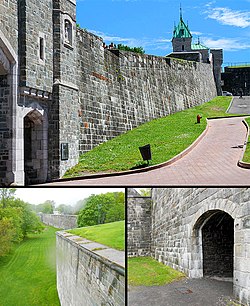| Ramparts of Quebec City Fortifications de Québec (French) | |
|---|---|
 Multiple views of the ramparts of Quebec | |
| Type | City wall |
| Location | Quebec City, Quebec, Canada |
| Coordinates | 46°48′36″N 71°12′42″W / 46.809973°N 71.211609°W |
| Built | 1690 |
| Rebuilt | 1745, 1820–1830s[note 1] |
| Architect | Gaspard-Joseph Chaussegros de Léry (1745) Gother Mann (1820–1830s) |
| Governing body | Parks Canada |
| Official name | Fortifications of Québec National Historic Site of Canada |
| Designated | 25 May 1948 |
The ramparts of Quebec City (French: Fortifications de Québec) is a city wall that surrounds the western end of Old Quebec's Upper Town in Quebec City, Quebec, Canada. The ramparts date back to the 17th century, with the ramparts having undergone a succession of modifications and improvements throughout their history. The city walls extend 4.6 kilometres (2.9 mi), with the southern portions of the ramparts forming a part of the Citadelle of Quebec.
The ramparts were first built in 1690 in order to defend the Upper Town of Quebec City. In 1745, the walls were rebuilt further west, modelled after designs created by Gaspard-Joseph Chaussegros de Léry. The ramparts withstood several sieges during the mid-18th century, with British forces holding out in the walled city during the French siege of Quebec in 1760, and the American siege of Quebec in 1775. From the 1820s to 1830s, the British expanded and improved the ramparts and the rest of the city's defensive network. However, by the late 19th century, several deteriorating facilities associated with Quebec City's fortifications were demolished, although the primary defences remained.
The city's defence complex, including its ramparts, were designated as the Fortifications of Québec National Historic Site in 1948. In addition to the ramparts, the national historic site also includes the Citadelle and the Lévis Forts. The ramparts, alongside the rest of Old Quebec, were designated as a UNESCO World Heritage Site in 1985; with the area serving as the only intact example of a fortified colonial settlement in North America north of Mexico.
- ^ "Porte Saint-Jean". Quebec City Tourism. 2021. Retrieved 1 February 2021.
- ^ "Porte Saint-Jean". Quebec City Tourism. 2021. Retrieved 1 February 2021.
- ^ "Military History". www.quebecheritage.com. City of Quebec. 2002. Retrieved 18 March 2008.Archived 11 September 2012 at archive.today
Cite error: There are <ref group=note> tags on this page, but the references will not show without a {{reflist|group=note}} template (see the help page).
© MMXXIII Rich X Search. We shall prevail. All rights reserved. Rich X Search
